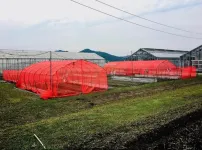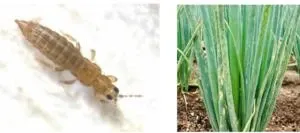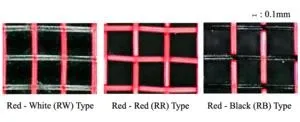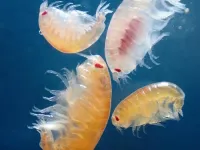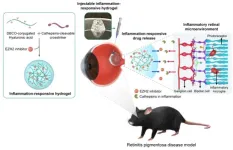(Press-News.org) Red nets are better at keeping away a common agricultural insect pest than typical black or white nets, according to a new study. Researchers experimented with the effect of red, white, black and combination-colored nets on deterring onion thrips from eating Kujo leeks, also called Welsh onions. In both lab and field tests, red nets were significantly better at deterring the insect than other colors. Also, in field tests, onion crops which were either partially or fully covered by red netting required 25-50% less insecticide than was needed for a totally uncovered field. Changing agricultural nets from black or white to red could help reduce pesticide use and the related negative impact it can have on the environment, while supporting more sustainable and effective agricultural practices.
Insect pests can be a nightmare for any gardener. No sooner do fresh buds appear then they are covered in aphids, beetles and other bugs looking for a tasty snack. While synthetic insecticides are widely used to control pests in gardens and on agricultural crops, many are known to cause damage to the natural environment by leaching into the soil and water supplies, and poisoning plants, wildlife and harmless insects. Some pests are also becoming resistant to the chemicals, so farmers are running out of options for what to use and needing to apply more often.
Agricultural nets are another way to protect crops and reduce insecticide use. You may see the typically white-, black- or blue-netted greenhouses when you pass by an orchard or vegetable field. Like a mosquito net over a bed, they physically prevent insects from getting to crops. It makes sense to think that the most important feature of these nets would be the size of the holes in the mesh. The smaller the hole, the smaller the insect has to be to enter. However, a research team from the Kyoto Prefectural Agriculture, Forestry and Fisheries Center and the University of Tokyo have found that the net’s color may act as an even more important deterrent.
“We tested red nets which had a mesh size that was larger than the insect body, but still more effective than other conventional black or white nets with a smaller mesh size. This ‘optical pest control’ relies on the nature of insect color vision to keep pests away,” explained Professor Masami Shimoda from the Graduate School of Agricultural and Life Sciences at the University of Tokyo. “Most insects don’t have red photoreceptors in their eyes and it is difficult for them to see the color red, so we found it curious that an invisible color can be used to control them.”
The team focused on one pest, the onion thrips (Thrips tabaci). This insect is highly resistant to insecticides and causes extensive damage to a range of important crops worldwide, by eating them and by spreading harmful viruses. The researchers tested three color combinations of red nets (red-white, red-black and red-red) at three mesh sizes (2 millimeters, 1 mm and 0.8 mm). They also tested typical black, white and black-white combination nets of the same sizes, in the lab and in the field.
Overall, all nets which included red fibers performed significantly better at keeping out onion thrips than black or white nets. In the second outdoor trial, the researchers tested the effectiveness of red-red netting at different levels of cover: no cover, full cover, top only and side only. Due to an outbreak of onion thrips in the area, insecticide was used. The fully covered plot required the least amount of insecticide and produced onions of high commercial value. The plots which were only ceiling or side covered required one additional application of insecticide, compared to the fully covered plot. Compared to the completely uncovered plot, the red-netted plots overall reduced the number of insecticide applications needed by 25-50%.
“These new red nets are more expensive than pesticides, but they are economical because they can be used for years. They are also very effective in controlling pests without all the work involved in spraying pesticides,” said Shimoda. “My dream is that in future we can make red nets that don’t look red — at least not to the human eye, but they would have the same effect on pests. Hopefully, this would reduce manufacturing costs, and we can find ways to increase durability.”
As well as reducing infestation by onion thrips, another advantage of red nets is that because they rely on color and not mesh size, they can have larger holes. This improves breathability, reduces the chance of fungal infections and improves access to sunlight. Also, due to better airflow, temperatures don’t become as high within the greenhouse, making it easier for farmers working inside.
“If consumers are interested in this type of sustainable agriculture and using less chemical pesticide, I have no doubt that this simple yet effective solution will spread widely,” said Shimoda. “My family have been full-time farmers since the Edo period (17th century), and I myself enjoy growing vegetables and fruits on a small scale, although pests can make it challenging. Growing your own fruits and vegetables and eating them fresh is exceptionally worthwhile.”
####
Paper Title:
Susumu Tokumaru, Yoshiaki Tokushima, Shun Ito, Terumi Yamaguchi, Masami Shimoda. Advanced methods for insect nets: Red-colored nets contribute to sustainable agriculture. Scientific Reports. DOI: 10.1038/s41598-024-52108-1
Funding:
This work was supported by Cabinet Office, Government of Japan, Cross-ministerial Strategic Innovation Promotion Program (SIP).
Useful Links
Graduate School of Agricultural and Life Sciences: https://www.a.u-tokyo.ac.jp/english/
Laboratory of Applied Entomology: https://webpark2276.sakura.ne.jp/en/
Research Contact:
Professor Masami Shimoda
Graduate School of Agricultural and Life Sciences, The University of Tokyo
Yayoi 1-1-1, Bunkyo-ku, Tokyo 113-8657, Japan
Email: m-shimoda@g.ecc.u-tokyo.ac.jp
Tel.: 03-5841-5062
Press contact:
Mrs. Nicola Burghall
Public Relations Group, The University of Tokyo,
7-3-1 Hongo, Bunkyo-ku, Tokyo 113-8654, Japan
press-releases.adm@gs.mail.u-tokyo.ac.jp
About the University of Tokyo
The University of Tokyo is Japan's leading university and one of the world's top research universities. The vast research output of some 6,000 researchers is published in the world's top journals across the arts and sciences. Our vibrant student body of around 15,000 undergraduate and 15,000 graduate students includes over 4,000 international students. Find out more at https://www.u-tokyo.ac.jp/en/ or follow us on X (formally Twitter) at @UTokyo_News_en.
END
Red nets signal “stop” to insect pests, reduce need for insecticides
Changing the color of commonly used agricultural nets lessens insect damage to Kujo Leek fields
2024-02-14
ELSE PRESS RELEASES FROM THIS DATE:
AI tool predicts function of unknown proteins
2024-02-14
A new artificial intelligence (AI) tool that draws logical inferences about the function of unknown proteins promises to help scientists unravel the inner workings of the cell.
Developed by KAUST bioinformatics researcher Maxat Kulmanov and colleagues, the tool outperforms existing analytical methods for forecasting protein functions and is even able to analyze proteins with no clear matches in existing datasets[1].
The model, termed DeepGO-SE, takes advantage of large language models similar to those ...
Promising new therapeutic approach for treating metastatic pancreatic cancer
2024-02-14
A research paper published today (14 February 2024) in Nature Cancer details new insights into the role of efferocytosis – the burying of dead cells – in pancreatic cancer that spreads to the liver.
Liver metastasis occurs in 40–50% of people with pancreatic ductal adenosarcoma (PDAC), and there are currently no effective therapies to cure pancreatic cancer patients that have liver metastasis.
Led by University of Liverpool’s Professor Michael Schmid and colleagues, this study found PDAC metastases to show high levels of immunosuppressive macrophages, a type of white blood ...
Neuronal insights: flash and freeze-fracture
2024-02-14
Fear and addiction exert significant influence within society. Managing them is often challenging, as they are driven by intricate neuronal circuits in our brains. Understanding the underlying molecular mechanisms is crucial to intervene when these processes malfunction. Pioneered by scientists at the Institute of Science and Technology Austria (ISTA), the novel “Flash and Freeze-fracture” technique provides a unique glimpse into the respective brain region. The results were recently published in the journal PNAS.
While looking for food, a bird encounters a fox. It gets away just in time, but the sight ...
Tiny crustaceans discovered preying on live jellyfish during harsh Arctic night
2024-02-14
In the dark and cold of the months-long polar night, food resources are limited. Some groups of marine organisms in the polar regions overcome this challenge by going into a metabolic resting state in winter, surviving on reserves accumulated during the short growth season. But others, such as several species of marine zooplankton, have evolved a different strategy: they shift from a specialized to an omnivorous diet during the polar night, profiting from a wide range of potentially less rewarding foods that are available throughout the year.
Now, ...
It's award season: let's celebrate microbes in movies
2024-02-14
Elche (Spain), January 22, 2024. Usually, show business depicts viruses, bacteria, and other microorganisms as one of the worst menaces to humankind. Entertainment movies influence the way audiences understand and perceive these topics. Yet, few films accurately portray the science of microbiology and its social implications. Movies and TV series often feature outbreaks of deadly diseases and the efforts of scientists and medical professionals to contain them. However, entertainment movies can also educate the public about the importance and the impact ...
New treatment developed to dramatically slow down the progression of blindness-causing retinal diseases
2024-02-14
The Korea Institute of Science and Technology (KIST) announced that Dr. Maesoon Im of the Brain Science Institute, together with Prof. Seung Ja Oh of Kyung Hee University and Prof. Kangwon Lee of Seoul National University, successfully incorporated anti-inflammatory drugs into a hydrogel to suppress inflammation in the retina and effectively deliver the drugs to the inflamed area.
Age-related macular degeneration and retinitis pigmentosa are incurable eye diseases that cause blindness due to the gradual damage of photoreceptor cells, which convert light into biological signals in the retina, the light-sensitive tissue at the back of the eye. Age-related macular degeneration is a condition ...
Menopause and migraines: New findings point to power of prevention
2024-02-14
For middle-aged women plagued by migraines, or hot flashes and night sweats, another worry may linger in the backs of their minds: whether these experiences have set them up for a heart attack, a stroke or another cardiovascular crisis.
After all, past research suggesting such a link during and after menopause has gotten a lot of attention.
But a pair of new studies in the journal Menopause suggest that most of them don’t need to worry as much, especially if they don’t have both migraines and long-term hot flashes and night sweats.
Instead, they should focus on tackling the ...
The combination of migraine and persistent hot flashes could prove deadly
2024-02-14
CLEVELAND, Ohio (Feb 14, 2024)—Hot flashes and migraine (particularly with aura) have been shown to be individual risk factors for cardiovascular disease because of associated poorer heart disease riskfactor profiles. A new study, however, is the first to examine the joint influences of migraine and hot flashes/night sweats (vasomotor symptoms) independent of traditional heart disease risk factors and estrogen use. Research results are published online today in Menopause, the journal of The Menopause Society.
Specifically, ...
Acupuncture may curb heightened risk of stroke associated with rheumatoid arthritis
2024-02-14
A course of acupuncture may curb the heightened risk of stroke associated with rheumatoid arthritis, finds a comparative study published in the open access journal BMJ Open.
The effects seem to be independent of sex, age, medication use, and co-existing conditions, the findings indicate, prompting the researchers to suggest that the procedure may reduce levels of pro-inflammatory proteins (cytokines) in the body that are linked to cardiovascular disease.
The principal cause of death in people with rheumatoid arthritis is cardiovascular disease. And they are more likely to have a stroke than ...
Poor quality clinical data informing NICE decisions on treatments in over half of cases
2024-02-14
The quality of evidence submitted to the National Institute for Health and Care Excellence (NICE) for informing its decisions to recommend technologies for use in the NHS was poor in more than half of cases, reveals a 20-year analysis, published in the open access journal BMJ Open.
And the data quality submitted for health technology appraisals by manufacturers between 2000 and 2019 was consistently poor, with no improvement during that time, the analysis shows.
NICE advises the NHS on the ...
LAST 30 PRESS RELEASES:
Making lighter work of calculating fluid and heat flow
Normalizing blood sugar can halve heart attack risk
Lowering blood sugar cuts heart attack risk in people with prediabetes
Study links genetic variants to risk of blinding eye disease in premature infants
Non-opioid ‘pain sponge’ therapy halts cartilage degeneration and relieves chronic pain
AI can pick up cultural values by mimicking how kids learn
China’s ecological redlines offer fast track to 30 x 30 global conservation goal
Invisible indoor threats: emerging household contaminants and their growing risks to human health
Adding antibody treatment to chemo boosts outcomes for children with rare cancer
Germline pathogenic variants among women without a history of breast cancer
Tanning beds triple melanoma risk, potentially causing broad DNA damage
Unique bond identified as key to viral infection speed
Indoor tanning makes youthful skin much older on a genetic level
Mouse model sheds new light on the causes and potential solutions to human GI problems linked to muscular dystrophy
The Journal of Nuclear Medicine ahead-of-print tip sheet: December 12, 2025
Smarter tools for peering into the microscopic world
Applications open for funding to conduct research in the Kinsey Institute archives
Global measure underestimates the severity of food insecurity
Child survivors of critical illness are missing out on timely follow up care
Risk-based vs annual breast cancer screening / the WISDOM randomized clinical trial
University of Toronto launches Electric Vehicle Innovation Ontario to accelerate advanced EV technologies and build Canada’s innovation advantage
Early relapse predicts poor outcomes in aggressive blood cancer
American College of Lifestyle Medicine applauds two CMS models aligned with lifestyle medicine practice and reimbursement
Clinical trial finds cannabis use not a barrier to quitting nicotine vaping
Supplemental nutrition assistance program policies and food insecurity
Switching immune cells to “night mode” could limit damage after a heart attack, study suggests
URI-based Global RIghts Project report spotlights continued troubling trends in worldwide inhumane treatment
Neutrophils are less aggressive at night, explaining why nighttime heart attacks cause less damage than daytime events
Menopausal hormone therapy may not pose breast cancer risk for women with BRCA mutations
Mobile health tool may improve quality of life for adolescent and young adult breast cancer survivors
[Press-News.org] Red nets signal “stop” to insect pests, reduce need for insecticidesChanging the color of commonly used agricultural nets lessens insect damage to Kujo Leek fields
